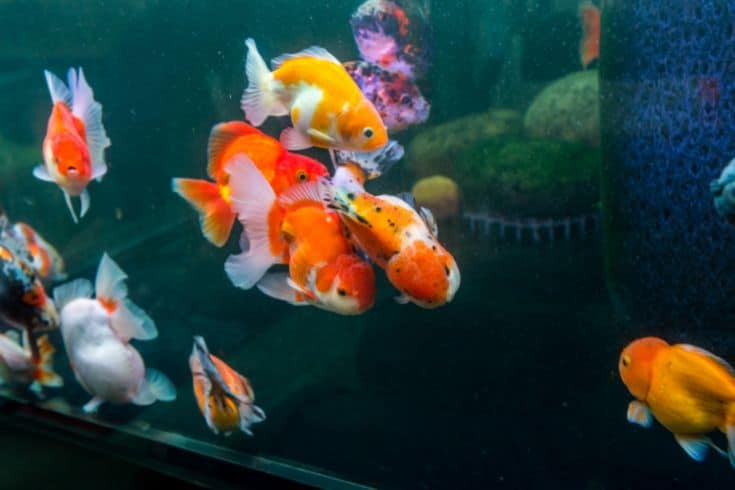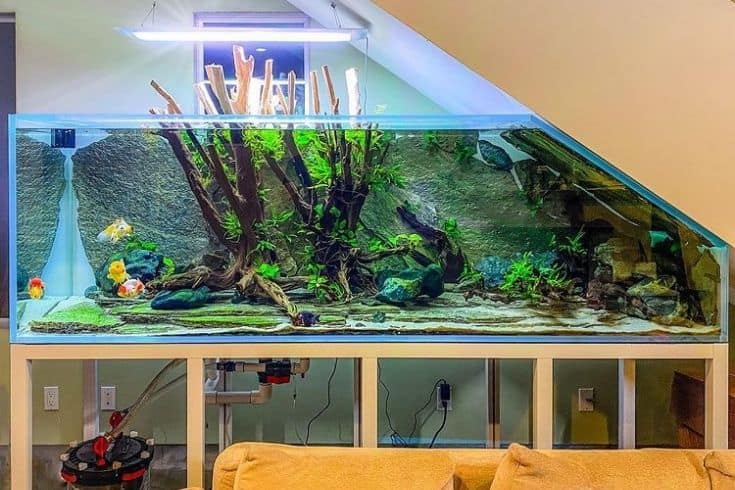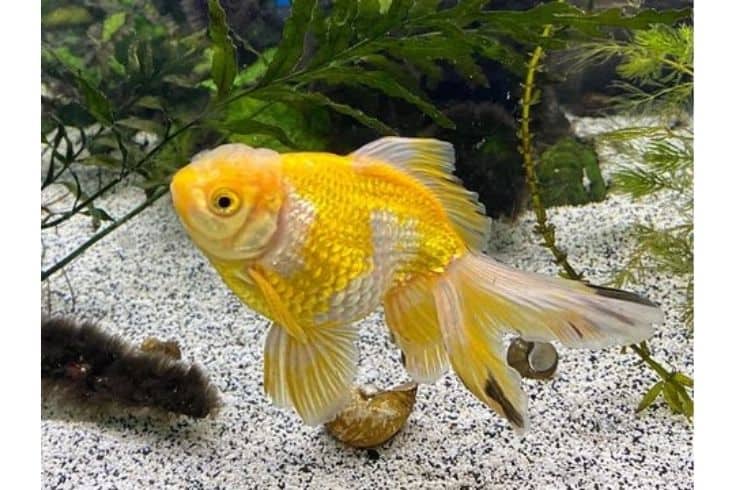Goldfish are wonderful family pets and are often admired as ornamental pond fish in many back gardens. These delightful fish come in over 200 varieties, and their different colors, shapes, and sizes certainly offer plenty of choices.
Most goldfish types grow to measure over 6 inches in length, with many of the slim-bodied types growing to over a foot long. So, it’s critical that you have a large tank or pond to house them.
If you have the space, a 75-gallon tank gives you lots of scope for keeping goldfish. But how many goldfish can live in a 75-gallon tank?
By allowing 10 gallons of water per goldfish, you could keep seven or eight goldfish in a 75-gallon tank, although sticking to five or six fish is better, given how dirty they are.
Read this guide to learn more about how many goldfish you can have in a 75-gallon tank.
75 Gallon Tank – How Many Goldfish Can You Have?
As a general rule of thumb, you can keep one goldfish per 10 gallons of water. This means that you could theoretically keep 7-8 goldfish in a 75-gallon tank. However, it’s important to note that goldfish are very messy fish and produce a lot of waste. For this reason, it’s best to avoid caution and stick to a maximum of 5-6 goldfish for aquarium tanks that are 75 gallons or larger.

In short, our recommendations are as follows:
- Size of tank: 75 gallons
- Number of Adult Goldfish: 5-6 goldfish
- Stocking Guidelines for Juvenile Goldfish: One inch of fish per gallon of water
Additionally, it’s important to remember that goldfish grow quickly! They can reach their full size in just 2-3 years, so opting for the minimum tank size is not a good idea. A 75-gallon tank will give your goldfish plenty of room to grow and provide them with a comfortable home for years to come.
I was once given a small fish tank and a couple of juvenile fancy goldfish as a birthday present from a friend. It was a lovely thought, but I knew I’d soon have to upsize the tank or rehome the fish as they would quickly outgrow their new home.
Sure enough, within a couple of months, the little fish had trebled in size, and the tank was starting to look too small. I didn’t want to part with my pets, so I upgraded the tank to a larger one.
A year passed, and the fish continued to grow at an alarming rate until, in the end, I had no choice but to relocate them to a garden pond built by my OH! To my delight, the fish spawned, and the pond soon had a few new additions that survived to adulthood.
The moral of this story is that you must remember how big your goldfish can get and start off with a large enough tank in the first place!
What Affects The Number of Goldfish You Can Keep In A Tank?

You need to consider a few factors when trying to determine how many goldfish you can keep in your tank. These include the following:
Species of Goldfish
It makes intuitive sense that some species of fish require more water than others, but did you know that the specific subtype of goldfish can also play a role in how much water your fish needs? For example, common goldfish can grow to be 12 inches long, which means that you can only keep around 6 in a 75-gallon tank.
On the other hand, most fancy goldfish tend to max out at around 6 inches, so you could theoretically keep up to 12 in the same sized tank. Of course, these figures assume that you want to max out your stocking density, which is generally not recommended since goldfish are such messy eaters. In fact, opting to house a single goldfish in a tank can also be a good idea since it will give your fish plenty of room to grow.
Another important thing to remember is that the immunity of species differs, which means that some are more resistant to diseases than others. For example, fancy goldfish are known to be more disease-prone than common goldfish, so you’ll need to take extra care if you decide to keep them.
Tank Shape
Another thing that you need to consider is the shape of your tank. Believe it or not, the tank’s shape can affect how many fish you can keep in a tank. The difference between a 30-gallon tank that is rectangular and a 40-gallon tank that is hexagonal is significant.
With a rectangle-shaped tank, the length of the tank is much longer than the width. This means that there is more fishable surface area in a rectangular tank than there is in something like a bubble-shaped tank. Common tanks are shaped like the former for a reason – rectangle tanks offer more space for swimming, which is important since goldfish are such active swimmers.

Custom-shaped tanks can also be a good option for goldfish, as long as you opt for fish tank shapes that offer a lot of swimming space. For example, a bowfront design makes a suitable tank because it provides deeper water depths in the center of the tank while still offering plenty of space for swimming. You can also find corner fish tanks that are specifically designed to make the most of limited space – this is a good sign of a suitable tank for your fish!
Filtration
Nothing makes water bad for fish like poor filtration. In fact, one of the most common mistakes that people make when stocking their tanks is not taking filtration into account. You’re practically asking for trouble when you combine a limited tank space with polluted water.
Any tank with goldfish should have a filter that can turn over at least 4 times the tank’s volume per hour. So, for a 75-gallon tank, you would need a filter that can turn over at least 300 gallons per hour. It’s also a good idea to have a backup filter on hand, especially if you own one of several types of tanks that are known to be difficult to filter.
Overstocking a tank can also lead to ammonia and nitrite spikes, which can be lethal to fish. If you’re not sure whether your tank is overstocked, it’s always better to err on the side of caution and get a larger filter.
What Happens When You Overstock A Tank?
So we’ve talked about how overstocking a tank can be detrimental to the health of your fish, but what exactly happens when you put too many fish in a tank? Here are some of the most common problems that can arise:
Illness and Disease
One of the most common problems that arise from overstocking a tank is illness and disease. When you have too many fish in a tank, the water becomes polluted more quickly, which can lead to a number of health problems for your fish. This includes severe conditions such as hole-in-the-head disease.
In addition, the build-up of waste can also lead to ammonia and nitrite spikes, which can be lethal to fish.
Behavioral Problems
Another common problem that can arise from overstocking a tank is behavioral problems. When you have too many fish in a tank, they can become aggressive towards each other.
Even though goldfish are typically peaceful fish, they can still become aggressive when they’re overcrowded. Think about it – if you were cramped in a small space with other people, you would probably start to get on each other’s nerves after a while!
Stunted Growth
This problem is often seen in goldfish that are kept in bowls or other small tanks. When fish are overcrowded, they don’t have enough room to swim and grow properly. As a result, their growth is stunted and they don’t reach their full potential size.
Stunted growth may not seem like a big deal, but it can lead to several health problems for your fish. For example, stunted fish are more likely to develop deformities and are also more susceptible to illness and disease.
Given all these problems, it’s easy to see why overstocking a tank is such a bad idea. If you’re unsure whether your tank is overstocked, read on to understand some key signs you need a larger tank.
Signs You Need A Larger Tank

While you can theoretically stuff goldfish into 6-gallon tanks and call it a day, it wouldn’t be long before you realize something is wrong. Goldfish may be very resilient creatures, but even the hardiest species of goldfish will eventually succumb to poor living conditions. These fish are not built for life in a tiny bowl.
The signs that your tank is too small are pretty easy to spot if you know what to look for. For starters, your fish may seem to be constantly gasping for air at the surface of the tank. Another sign that your tank is too small is if you notice your fish starting to experience rapid and erratic movements. This happens because the fish are trying to get more oxygen, but they’re not able to because the water is too crowded.
The final sign that your tank is too small is if you notice your fish starting to get skinny. This happens because the fish are not able to get enough food, and they’re burning more energy than they’re taking in. If you notice these signs in your fish, it’s a sure sign that you need a larger size tank.
The Bottom Line
Aquarium tanks come in all sorts of shapes and sizes, but not all of them are suitable for goldfish. Thankfully, a 75-gallon tank is more than enough to house a small group of goldfish. Just remember to take filtration into account, and to avoid overstocking your tank. With a little bit of care, your goldfish will thrive in their new home!
Did you enjoy this article? Please share it with your friends! And if you have any lingering questions, feel free to leave them in the comments section below! Check out our other articles on goldfish care for more tips on keeping your fish happy and healthy, and thanks for reading! Happy fishkeeping!
